After our series of articles on swimming pools, here's a hot tub review that I find particularly interesting: the NetSpa Octopus. This one has the particularity of being semi-rigid, for a price close to that of an inflatable hot tub. The big advantage, of course, is that it won't be punctured, while offering a much more “classy” design! Having a hot tub at home is not only a luxury, but a real asset for relaxation and health. Plunging into a hot tub after a stressful day allows you to deeply relax. The massaging water jets relieve muscle tension, promote blood circulation, and help reduce stress and anxiety.In terms of health, the benefits are numerous. Hot baths stimulate the production of endorphins, the happy hormones, and can help improve sleep quality. In addition, they can relieve joint and muscle pain, improve muscle flexibility, and promote better recovery after exercise. For those suffering from chronic conditions like arthritis, regular hot tub baths can significantly reduce pain and improve mobility. Personally, it's a device I really appreciate. But a rigid hot tub is very expensive. After starting out with an inflatable hot tub a few years ago, I switched to this semi-rigid model this year, discovered somewhat by chance, which turns out to be an excellent compromise between an inflatable hot tub and a rigid hot tub.Let's take a closer look.
Discovery and Installation of the NetSpa Octopus
The NetSpa Octopus comes in a fairly heavy (about 40 kilos) and bulky box. It's best to have two people to handle it!
As you can see on the packaging, this is a model for 6 people: in reality, up to 4 adults and two children.
On the side, you'll find the list of items included:
Inside, everything is perfectly wedged. Two-thirds of the packaging contains the foam blocks that make up the spa walls. It's hard to find better protection :p
The walls are actually made of foam blocks about ten centimeters thick, very rigid:
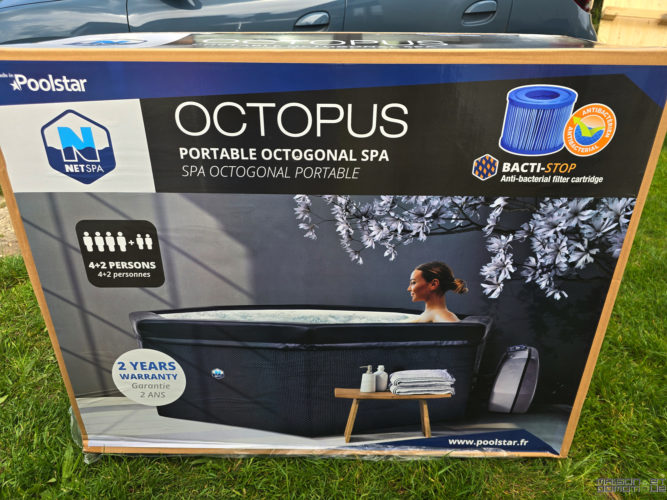
Once everything is out of the packaging, we have our walls, the edges, a floor mat, a liner, a protective cover, a motor unit, and finally the instructions, along with everything you need to repair any leaks.
After a quick read through the manual, all that's left is to start the assembly!
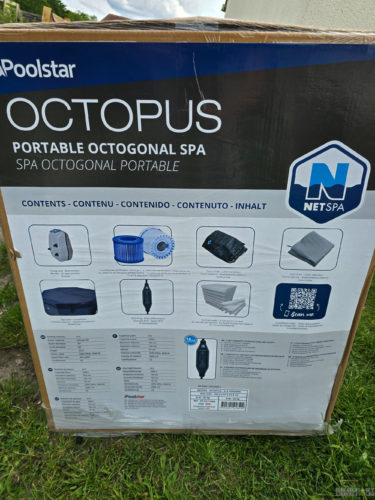
We start by placing the black woven PVC floor mat, giving it roughly the octagonal shape it's supposed to have. The floor section includes foam for added comfort. Be careful, one of the sides has holes. This is where the motor unit will be connected. You'll therefore need to make sure it's oriented in the direction you want the unit to be. Next, place the foam blocks that make up the walls. One of the blocks also contains holes. These should be aligned with those in the floor mat.
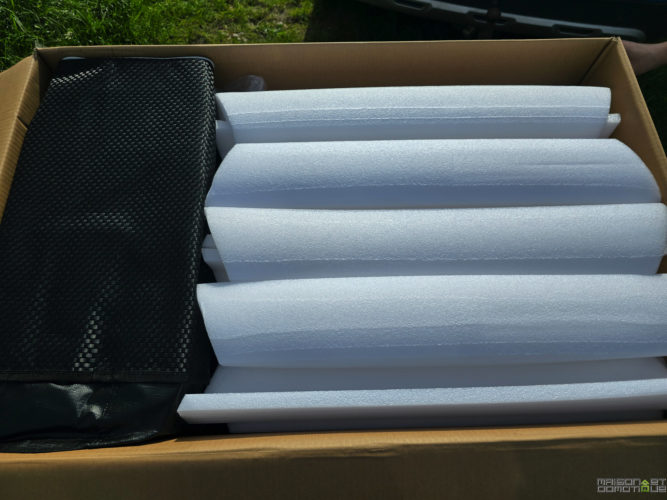
Then simply place the other blocks one after the other. The floor mat holds them in place:
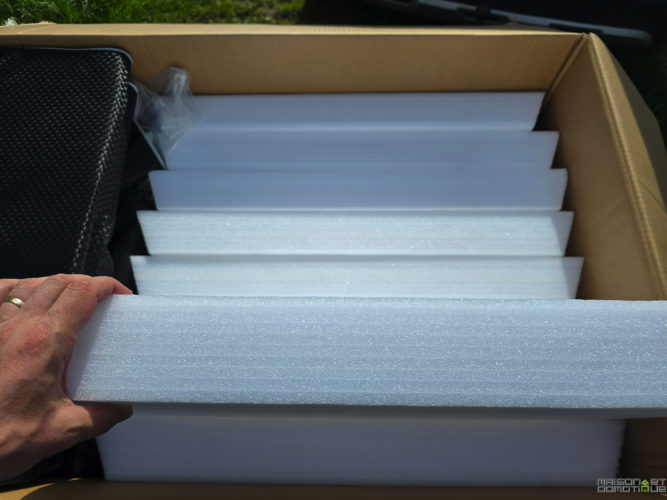
The trickiest part is the last one, which requires a bit of shoehorning. But the whole thing holds perfectly once it's wedged in place. Care must be taken to keep the floor mat taut so that it takes its proper shape.
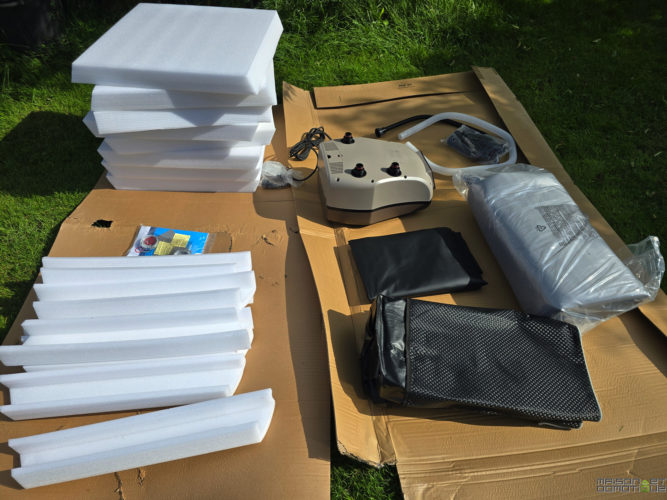
The coping stones can then be placed on each wall:
All that's left is to place the liner inside the spa, which also contains the entire bubble system:

Be careful, this has four pipes, which must be aligned with the holes seen above on the wall. These are the water inlet and outlet nozzles, the air hose for the bubbles, and the drain hose for emptying the spa.
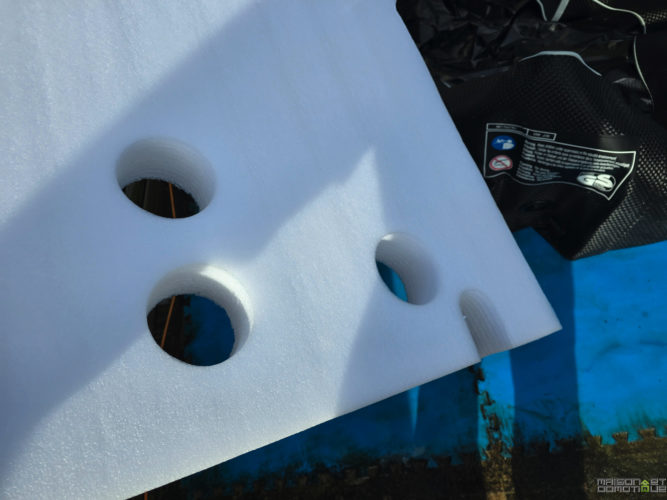
The liner is stretched taut, especially on the floor. Once it's securely in place, all that's left is to connect it to the floor mat using the provided zipper:

Okay, this is clearly the trickiest part, because the liner and the floor mat need to be properly aligned for the zipper to begin, and taut enough to leave the minimum amount of space between them for the zipper to slide. I had to try twice, but once it's closed, it's all good!
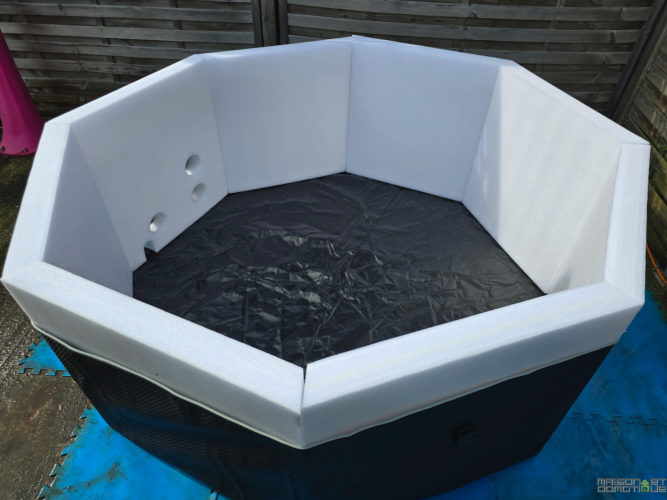
Now we can install the filter. Don't bother looking for it; it's hidden inside the motor unit, with a compartment provided for storage.

We insert the fabric filter into the plastic unit, which we screw onto the lowest nozzle:
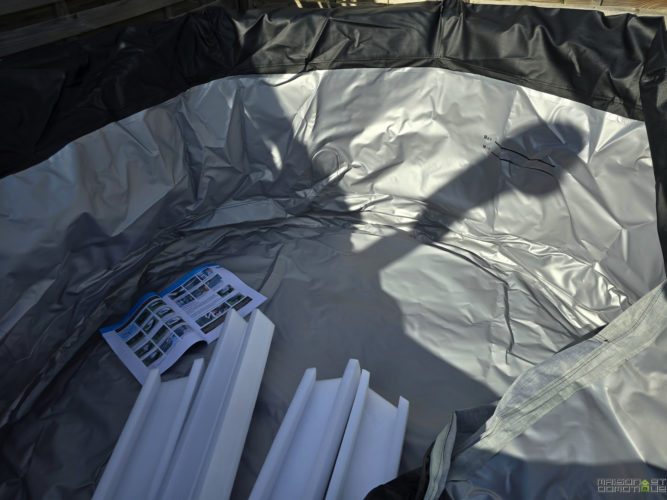
We can now connect the motor unit. Simply align it with the pipes coming out of the spa and screw them together:

These pipes have a seal at each end and a screw ring, which should prevent any leaks, unlike other systems that are a bit “lightweight.”
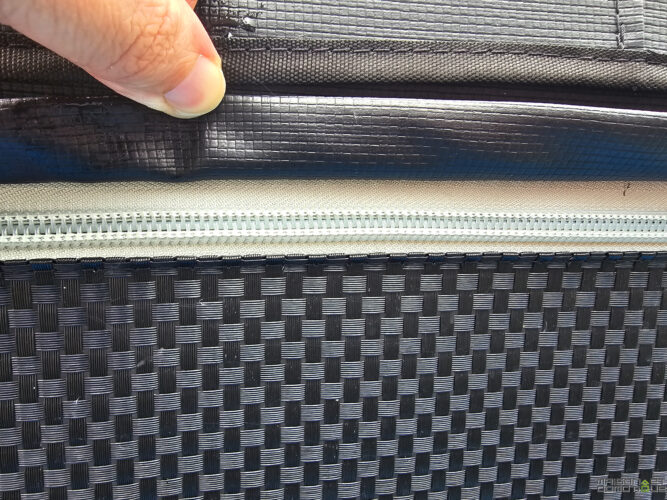
Once installed, this spa measures 193cm in diameter (external) and 73cm in height. This size remains compact considering its volume, compared to a traditional inflatable spa, whose walls are generally thicker.
All that's left is to fill the spa with water, respecting the minimum and maximum limits. Be careful, while the maximum limit may seem low once filled, it turns out to be perfect once 4 people are in the spa ;-) It takes approximately 1000 liters to fill it properly.
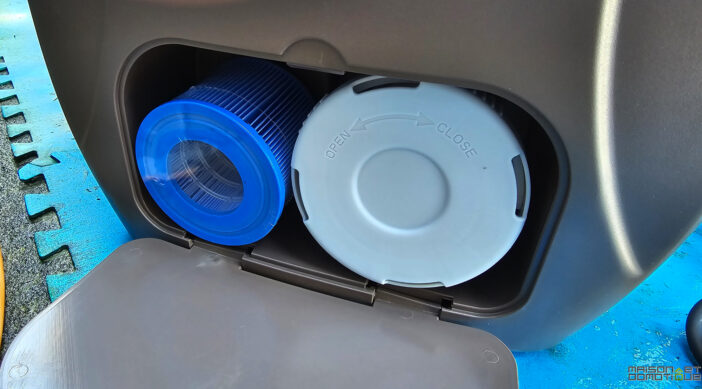
It is recommended to fill 2-3cm of water, then stretch the bottom of the liner before filling it further, as you would with a freestanding pool, for example. Once level, you can turn on the heating to be able to enjoy it as soon as possible, and cover the whole thing with its protective cover:
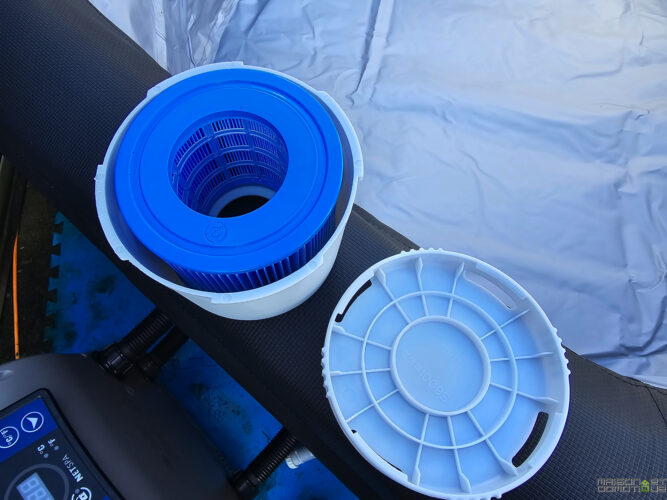

Unlike most inflatable spas that have a rigid, inflatable cover, here we only have a protective cover, but it features multi-layer insulation, as is sometimes used in construction:
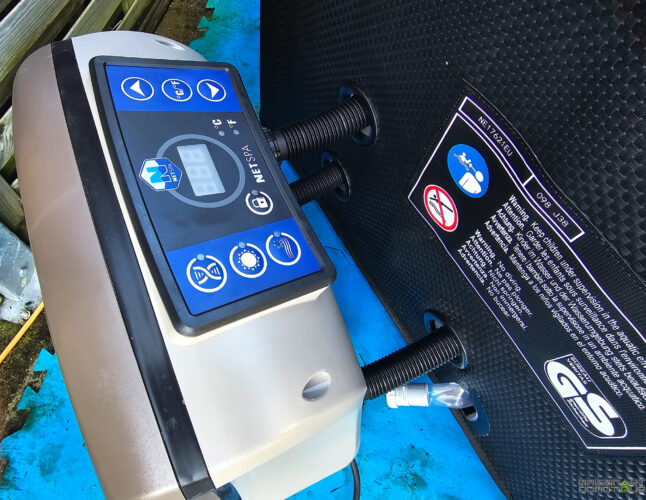
The whole thing is tensioned via four buckles, which also have a child safety lock to prevent children from easily opening it:
The manufacturer claims 15 minutes for assembly. Well, I spent 30 minutes, taking the time to take the photos. And if I hadn't stumbled on the zipper, it would have taken much less time. In short, the installation time is still very quick.
All that's left is to let it heat up before enjoying!
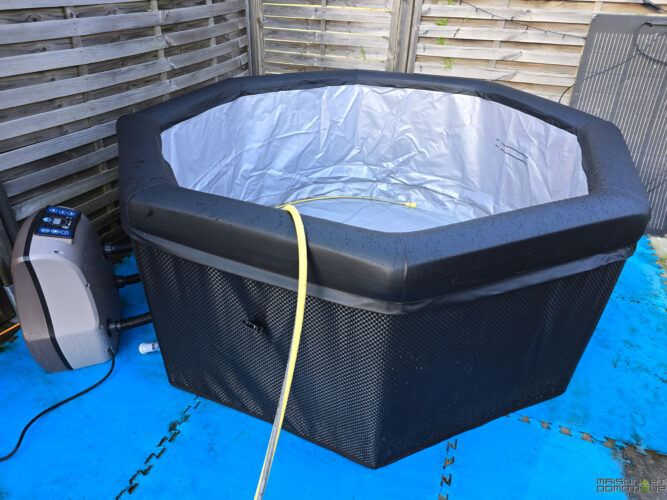
Using the Netspa Octopus Semi-Rigid Spa

The heating time will, of course, depend on the temperature of the filling water, the desired temperature, and the weather. Indeed, if the sun is warm, you can quickly gain a few degrees without resorting to electric heating. Generally, the spa warms 2 to 3°C per hour. Here, I had the water filled at 19°C. It took me about ten hours to reach the 38°C I wanted, because it ran overnight during off-peak hours (I had installed it one evening).
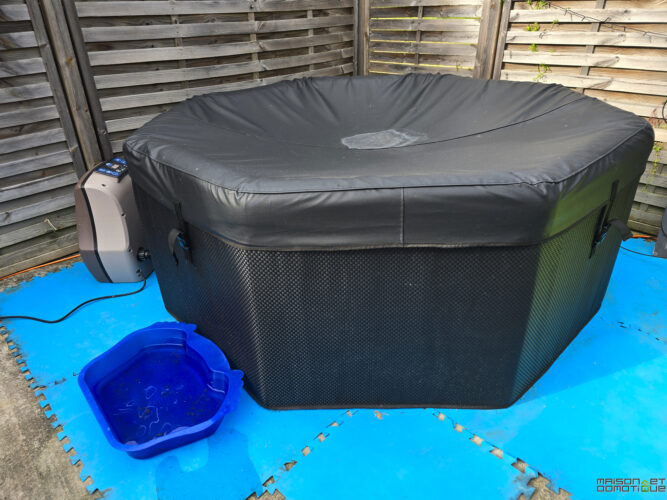
The control panel is very easy to use. At the top left, we have the filtration, below that, the heating, then the bubbles. The latter automatically turns off the filtration and heating. The bubbles automatically stop after 30 minutes, and if the heating or filtration were running beforehand, they resume operation. On the right, we simply have the temperature adjustment buttons.
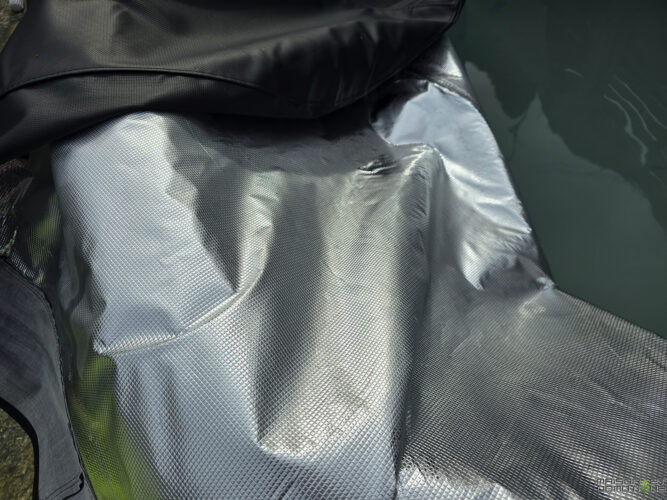
There's also a lock button (padlock) to lock the controls, which is useful for preventing children from tampering with them, for example.
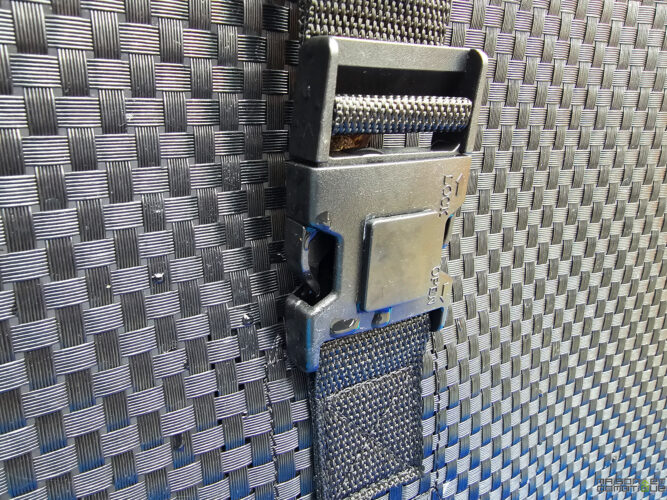
When you want to enjoy the spa, simply remove the cover and get in the water, for a truly enjoyable moment of relaxation:
First observation: being a bit higher than my old inflatable spa, you're submerged up to your shoulders and neck, without having to sink to the bottom of the spa when lying down. Sitting is very comfortable (I'm 1.80m tall).
This model has 100 jets all around, which massage the lower back. There are no water jets here, present only on higher-end models, but air jets, which are already very pleasant. However, four walls also have a vertical line of jets to massage the entire height of the back. The whirlpools throughout the spa then massage the rest of the body. At the end of the 30-minute session, you can of course turn the bubbles back on if you want to indulge in another relaxing session :)
The only thing that's a shame is that this spa isn't connected, so you can activate it from your smartphone (when you're at the office and think you'd love a spa when you get home in the evening). It's also not programmable, whereas my previous BestWay model had a timer setting (heating would start in x hours). The controls here are therefore very basic. With this model becoming more widely available, perhaps a developer will develop a card like those already available for Intex or Bestway? To be honest, I think it's still quite a “gimmick,” in the sense that to enjoy the spa whenever you want, the ideal is to leave it running continuously. We'll talk a little more about power consumption later.
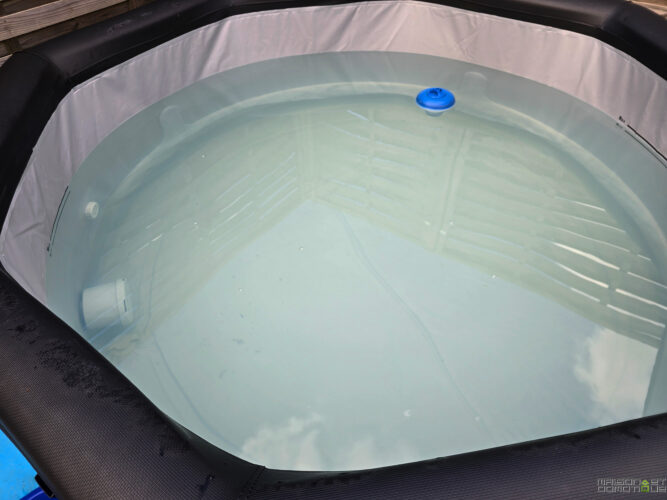
The Advantages of the Netspa Octopus Semi-Rigid Spa

This model is the second “general public” spa I've owned, after an inflatable model from Bestway. When comparing the different types of spas available on the market, this semi-rigid Netspa Octopus model stands out with several notable advantages.
Strength and durability: Unlike inflatable spas, semi-rigid spas like the Netspa Octopus offer greater strength and durability. Their reinforced structure allows them to withstand the elements and wear and tear more effectively. No more worrying about dog or cat claws either :p This translates into a longer lifespan and less frequent maintenance. I actually had to replace my BestWay because it kept deflating, and despite repairs, it didn't last. The lifespan of an inflatable spa is apparently 5 years, and it had outlived its useful life… I hope to be able to keep this semi-rigid spa much longer :)
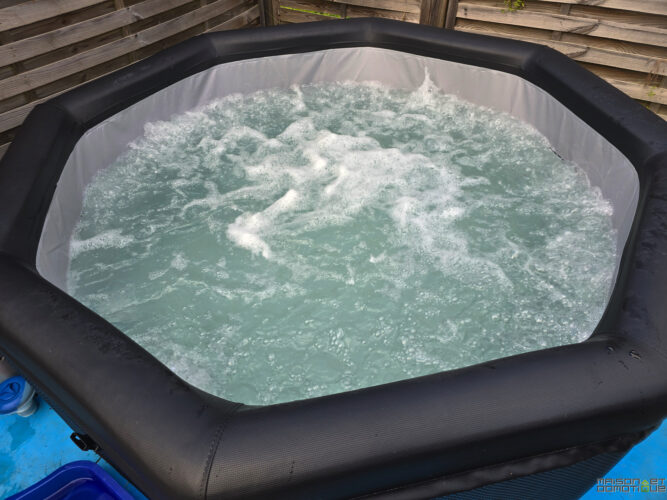
Thermal insulation: The thermal insulation of a semi-rigid spa is generally superior to that of an inflatable spa. The Netspa Octopus, thanks to its sturdy foam block construction, retains heat better, which reduces energy consumption to keep the water at the desired temperature. This feature is essential for optimizing operating costs, especially during the winter (because yes, such a spa can be used all year round!).
Comfort and performance: The Netspa Octopus is designed to offer a high-quality spa experience. Its powerful jets provide a more effective massage, comparable to that of high-end fixed spas. In addition, its octagonal shape offers a more generous and ergonomic interior space, allowing several people to comfortably enjoy the spa simultaneously. Be careful, however: while it's rated for 4 adults + 2 children (6-seater spa), it's actually comfortable for 4 people, with 2 being the most comfortable :D
In short, while not as expensive as a “real” rigid hot tub, the semi-rigid hot tub offers significant improvements over a traditional inflatable hot tub. Note that some manufacturers advertise semi-rigid hot tubs that are, admittedly, rigid, but still require inflation, which carries the same puncture risk as traditional inflatable hot tubs. Therefore, not all semi-rigid hot tubs are created equal!
Precautions for Spa Maintenance
To fully enjoy your hot tub, whether it's this Netspa Octopus semi-rigid model or another, it's essential to follow a few maintenance precautions:
Filtration and Cleaning: Ensure the filtration system is working properly and clean the filters regularly to prevent the accumulation of debris and impurities. The Octopus will display a message every 150 hours of operation, reminding you to clean the filter. Please note that the supplied filter is not a simple paper filter, but an antibacterial fabric filter that only needs to be changed once a month, or once a week for paper filters. Simply hose it down once a week to clean it.
Water Treatment: Use appropriate chemicals to maintain a balanced pH and disinfected water. Regularly check the chlorine or bromine levels, depending on your preferred treatment. Please note that no product diffuser is included with the Octopus; it will need to be purchased separately. A connected probe, like those used for swimming pools, also makes it easy to monitor water quality ;-)
Spa Protection: Always cover your spa when not in use to prevent leaves, insects, or debris from falling into it. However, ideally, it should be aired for one hour a day to maintain healthy water.
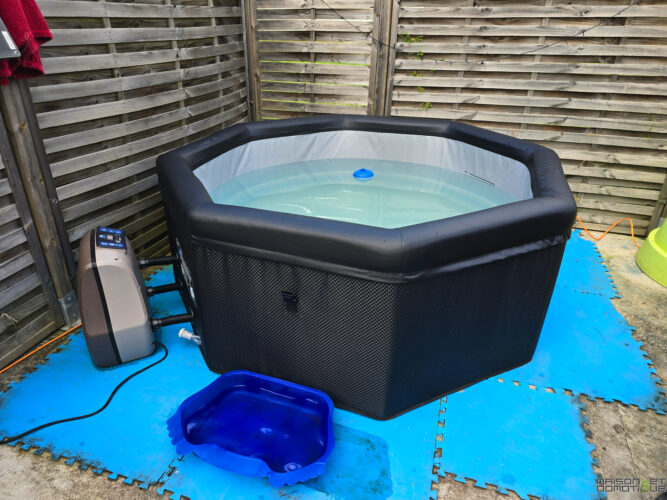
Draining and Refilling: Drain and completely clean your spa at least every three months to prevent the build-up of limescale and bacteria. This is a minimum if the water remains clear. Otherwise the manufacturer recommends replacement every month and a half ideally.
Electricity consumption of the spa: we take stock
A spa's electricity consumption can be an important factor to consider, especially given the price of electricity today. Here are some tips to optimize it:
- Insulation: Use the thermal blanket to retain heat and reduce the heating time required. The Netspa Octopus, with its superior insulation, is already advantageous in this regard.
- Temperature: Keep the water temperature constant, rather than heating it suddenly with each use. A temperature slightly below 37°C is often sufficient for a pleasant bath while saving energy. Operating hours: Heat your spa during off-peak hours, when electricity rates are lower. Or if you have solar panels, during the day when peak production is there, this allows you to heat the Spa for free ;-)Regular maintenance: A clean, well-maintained spa operates more efficiently. Clean filters and chemically balanced water reduce the workload on the heating and filtration system. I had “fun” monitoring the consumption of this model according to several types of use, by leaving it running 24 hours a day, or by only heating it up when I planned to use it. Home Assistant allowed me to track all of this precisely. Here, the spa remained for a day simply with the filtration on, without heating. It consumes around 40 wh, or 0.84 wh over a day (i.e. less than 14 cents over the day, or around €4 for the month).
- In this first case, I left the spa running with the heater on continuously until it reached 37°C. As you can see, the heater doesn't run 24/7, since it waits until it drops 2°C before turning on again. Over the day, this represents 8.56 kWh, which is more than my water heater 😅 But hey, here we're maintaining 1 m3 at 37°C compared to “only” 300 liters for the water heater, even though it heats almost twice as much. In terms of cost, this represents about €1.30 for the day (or about forty euros for the month).
- In this second case, I didn't turn on the heater until noon, because I planned to enjoy the spa in the evening. As you can see, the heater ran at full blast (1600 wh) for several hours in the afternoon to raise the temperature. At the end of the day, it still consumed 12.23 kWh, or nearly €2.
This last result varies greatly depending on the outside temperature, as on other days the spa only consumed 8.5 kWh to get back up to temperature.
Note that during the spa session, with only the bubbles running, the motor consumed 850 Wh.
- Ultimately, it turns out to be more economical to leave it running continuously. On the one hand, it's more convenient to enjoy it whenever you want: no need to “plan” that you'll be going tonight to remember to heat it up in advance; it's always ready to welcome you, even unexpectedly. On the other hand, the impact on the bill is “less of a problem.”
- Therefore, it's only worth turning off the heat when you know you won't be using it for several days, for example, when you have to go away. In this case, reheating will certainly consume a lot, but less than the x days when it would have run continuously for nothing.
- But as you can see, the spa still has a significant impact for those who pay close attention to their electricity bills, so it's an additional cost to consider for its use (aside from the maintenance products that are also required, but which remain very affordable).
- Conclusion
This semi-rigid spa caught my eye when I discovered it by chance while looking for a new spa. The non-inflatable aspect was particularly appealing to me, because between air leaks and water leaks, inflatable spas don't age very well, I find. Here, the design of the Netspa Octopus provides a certain peace of mind in this regard.
Setup and use are also very simple, and it must be said that this spa looks better than an inflatable spa, with its woven lower section and its imitation leather upper section. Aesthetics are important too :)
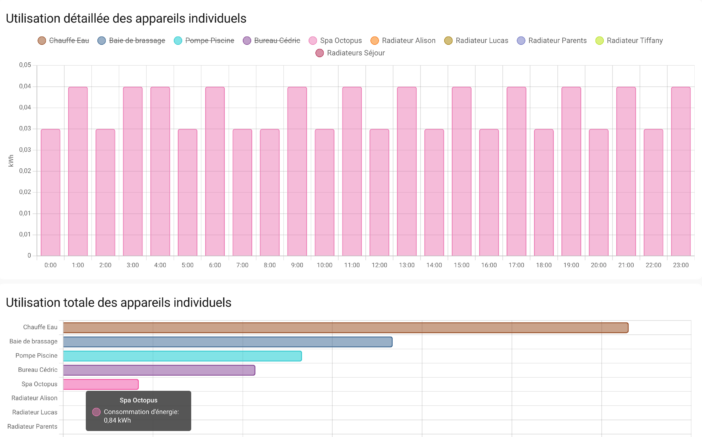
As for the comfort it provides, there's nothing to complain about. Its height allows for a comfortable immersion. The water can heat up to 42°C, which is well above my needs, and the bubbles really work. The vertical bubble strip at the back is also very pleasant. The motor is a bit noisy, but like all spas of this type, this one is actually quieter than my old model. But with the sound of the bubbles, you can't hear it much anymore. Adding the furniture will likely reduce the noise a bit.

In short, I'm completely satisfied with it! It's a little more expensive than an inflatable spa (although some models add up quickly), but it offers better performance and probably a longer lifespan.

Normally priced at €1,199, it's fairly easy to find online for less than €850.
Note that one of the advantages of this model is that it also comes with all the furnishings needed to create a true little corner of paradise. You can purchase one or more optional elements, or opt to buy the complete spa and furniture package, which is often much more affordable than purchasing them separately:


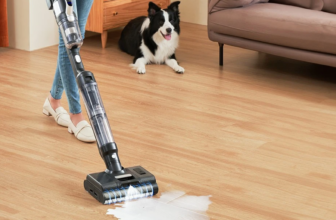
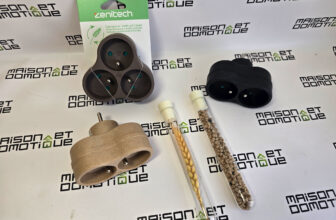
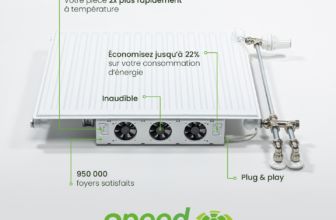
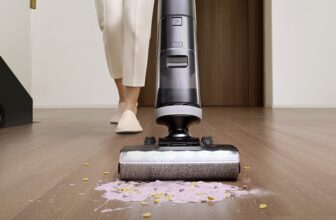

Please remain courteous: a hello and a thank you cost nothing! We're here to exchange ideas in a constructive way. Trolls will be deleted.